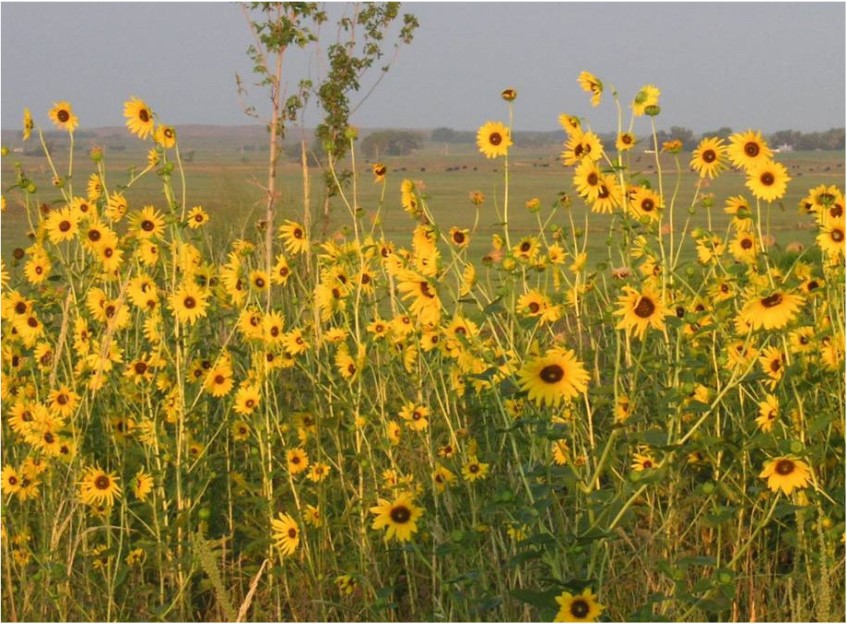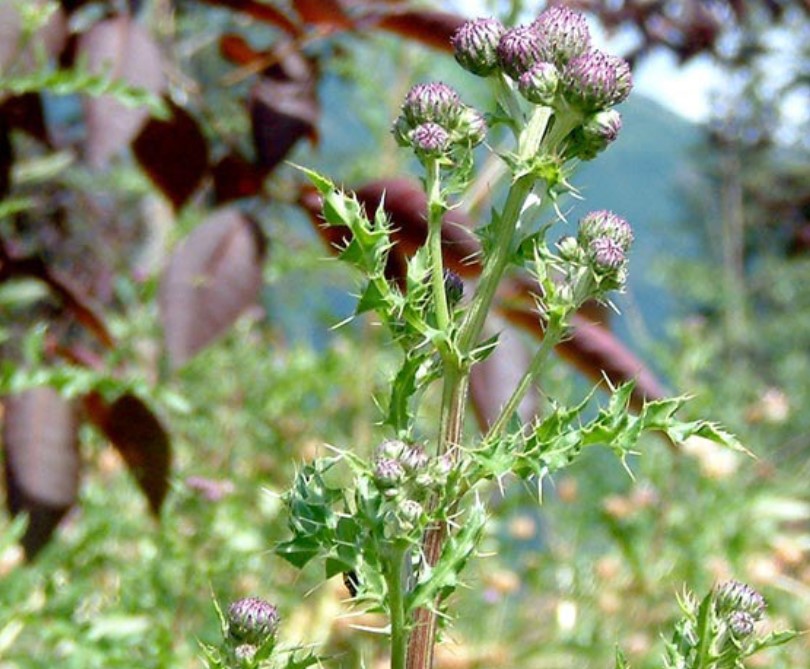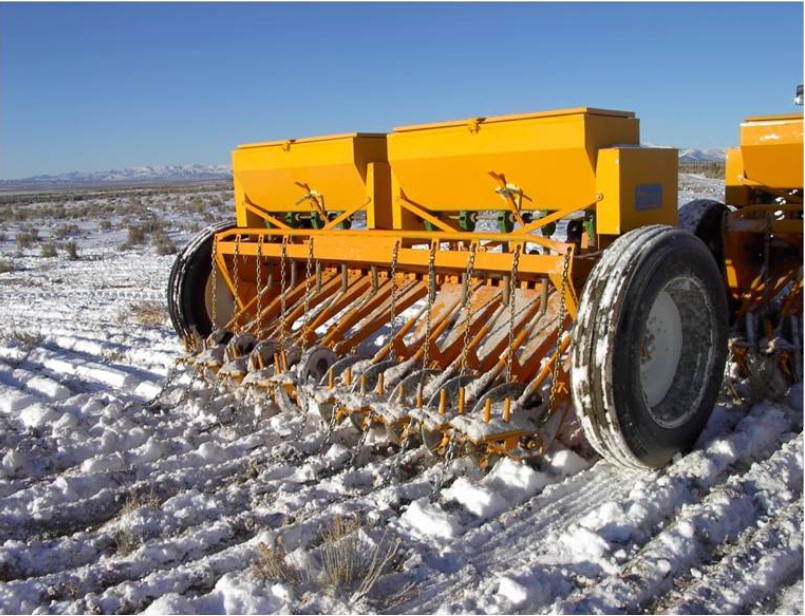
Pipeline Reclamation
This MontGuide provides a step-by-step guide for managing the risks associated with pipeline construction to increase the likelihood for successful pipeline reclamation.
Last Updated: 02/16by Merilynn Schantz and Erin Espeland, USDA-ARS-Northern Plains Area Research Laboratory, Sidney, MT; and Jane Mangold, Montana State University, Department of Land Resources and Environmental Sciences, Bozeman, MT
PIPELINES OCCUR THROUGHOUT MONTANA,
and poorly planned reclamation can lead to permanent disturbances, including weed invasion and soil erosion. Preventing these disturbances is possible by strategic planning
Introduction
Pipelines are an economical way to transport water, renewable energy, electricity, and fossil fuels. Because the reclamation of pipeline disturbed regions is often fast and relatively unplanned, large land areas may show damage or scars from disturbance. Landowners, livestock producers, wildlife managers, and recreationalists are all impacted because pipelines bridge property boundaries. Most pipelines are buried underground and designed to impact as little area as possible. In general, the greater the magnitude of disturbance (i.e. width and depth of excavation), the greater the potential for weeds and erosion. Areas with pre-existing problems, such as highly erosive land and/or areas that are currently invaded by weedy vegetation are at risk of further degradation following excavation. Yet, when pipeline reclamation is properly planned, resilient plant communities can be created, some of which may even be an improvement to the pre-pipeline plant communities. As part of this planning process, often landowners and pipeline companies agree on a site-specific lease plan that includes landscape recovery after construction. Because pipelines are a vital tool for maintaining resource and energy flow in our modern society, and we have the responsibility to maintain healthy and productive range and wild lands, identifying practical reclamation methods for arid range and wild lands is crucial. This publication outlines six key elements that should be considered when reclaiming land disturbed by pipeline construction.
Pre-disturbance check
Considering site conditions prior to pipeline excavation is important to identify potential problems and determine if a site has recovered to its original state post-construction. A plant inventory identifies plant species that could become weedy following excavation. Because a site currently infested with weeds may return to weeds following excavation, decreasing the spread of weeds prior to excavation is recommended. Targeted control practices that decrease weed abundance include pre-emergence herbicides and are further discussed in sections following. It may be prudent to seed more vigorous species or increase seeding rates at weed-threatened sites compared to sites dominated by natives. Prior to seeding, managers should identify the soil type using a soil survey. This can be completed online via web soil survey, websoilsurvey.nrcs.usda.gov. The soil survey identifies soil type, average climate, common native species for the region, and soil properties that could limit seeding success, e.g. salinity, sodicity, shallow bedrock, etc.
Preparing a seedbed
When a pipeline is excavated, typically the contractor sets aside the topsoil and places subsoil in another pile. After the pipeline is installed, subsoil is replaced and compacted. The topsoil layer is then placed on top. In areas where topsoil is extremely thin, or where there is a gypsum or sodic layer close to the soil surface, a landowner may wish to ensure that topsoil is not contaminated with lower layers. Mixing the topsoil with sodic layers reduces plant growth and hampers successful reclamation. Compaction of both subsoil and topsoil are necessary to retain soil at the site, but too much compaction makes it difficult for plant growth. In the case of failed revegetation, performing a soil analysis and measuring compaction may help identify the cause.
Seed beds should be constructed to improve water infiltration and to keep seeds on site. This means managing runoff. Water velocity can be slowed with the use of straw, and machinery tracks can be laid across slopes to slow water.
Weed control and management
Disturbances such as excavation for pipeline construction often result in a flush of ruderal or fast-growing weedy plants. Such plants grow quickly, produce a lot of seeds, and are typically short-lived annuals. Ruderal plants are not very competitive and rely on disturbance to persist in a plant community. Examples include prickly lettuce, lambsquarter, pepperweed, wild oat, and annual sunflower (Figure 1). Over time these species decline as longer-lived perennial species establish and flourish. If ruderal plants are common the first one to three years after reclamation, do not panic. Give the plant community time to establish.

FIGURE 1. Annual sunflower (Helianthus annuus L.) is an example of a ruderal weed that should be watched, but has not been shown to spread into intact range and wild lands. Photo by Merilynn Schant
Invasive weeds also flourish with disturbance, grow quickly, and oftentimes produce a lot of seeds. However, in contrast to ruderal weeds, invasive weeds are competitive, longer-lived, and do not require continued disturbance to persist in a plant community. Examples include leafy spurge, spotted knapweed, Canada thistle, field bindweed, and crested wheatgrass (Figure 2). Instead of declining over time, such species may continue to increase and interfere with successful reclamation. Control actions should be taken if invasive weeds are found at a reclamation site. A noxious weed species list, including identification and control practices, can be found at www.mtweed.org. Your local Extension office or weed district office can also provide information on identification and control.

FIGURE 2.Canada thistle (Cirsium arvense (L.) Scop) is an example of a noxious weed that should be controlled when first identified. Photo by UAF Cooperative Extension, University of Alaska-Fairbanks, Bugwood.org
Weeds can be controlled before or after pipeline construction. When possible, control prior to excavation. Advantages to this include reducing the number of weed seeds in the soil seed bank, decreasing the number of re-sprouting roots, and reducing the risk of re-invasion by weeds neighboring the pipeline. In addition, because soil disturbance increases weed spread, postponing weed control until after construction will result in higher densities of weeds that are more difficult to manage.
Most pipeline companies follow standard industrial hygiene protocols to prevent weed seeds or fragments from moving among construction sites. Landowners may request to see these standards as part of the lease negotiation process.
Treatment options:
Multiple control treatments are available for reducing weeds including chemical, prescribed fire, biomass removal, and biological control. Chemical control is a popular method for targeting weed infestations because it can be applied in small patches or over a large area, and it provides quick results. Many foliar-applied herbicides are non-selective, meaning they can be used to control several classes of plants including forbs (broadleaves), grasses, and shrubs. However, care should be taken when applying these herbicides because they affect a wide range of species, and non-target effects can harm desirable species.
Prescribed fire is a low cost management practice that can reduce weed dominance for the short-term and thereby open niches for desirable species to return. Biomass removal via livestock grazing or mowing can also effectively reduce weed abundance by reducing seed production, litter accumulation, and competition with desirable species. Mechanical controls include disking, tilling, raking, or cutting (for tree removal, for example). Although they can sometimes be costly, mechanical control methods typically work and can selectively target the undesirable weed, especially for large species like trees.
Biological control is the introduction of insects from a weed’s native ecosystem that feed exclusively on the weed and help to control or suppress the weed in the introduced region. Although this method is effective, it may not be appropriate for immediate reclamation of pipeline construction because of the time it takes to be effective.
Treatment options should be tailored to the weeds present at the site because some treatments work better depending on growth characteristics of weeds (e.g., class of plant, life history [annual or perennial], type of roots [taproot or rhizomatous]). The integration of methods is also encouraged as integrated weed management often results in better long-term control than relying on only one type of treatment.
Seed Mixes
Choosing a seed mix can be one of the most difficult steps in reclamation. It is important to choose the right species for the site to have the greatest chance of producing a healthy stand of desirable vegetation. If possible, choose a mix of warm and cool season grasses, forbs, and shrubs. Often pipeline companies subcontract reclamation seeding to specialized practitioners, who may use the same mix for the whole pipeline. Landowners with strong opinions regarding the seeding mix should be clear about their opinions as early as possible in the construction process. For more information Table 1 indicates a list of native species that are well suited for seeding on eastern Montana rangelands.
Select species that will grow best given soil conditions at the site. Saline and sodic soils limit the species that will grow following pipeline construction. For example, western wheatgrass and Russian wildrye can tolerate soils with high salinity, while the forbs scarlet globemallow and purple prairie clover have low tolerance for salinity. Alternatively, if soils are prone to erosion because of steep slopes or in areas of frequent disturbance, such as near streams and rivers, it is important to select species that will grow quickly and tolerate frequent disturbances. Western wheatgrass is one species that can grow along streams and riverbanks that is also tolerant of high traffic from livestock, wildlife, or humans.
Seeding rates should be adjusted to the desired outcome. Grasses will likely establish first and high perennial grass seeding rates, ranging from 8-10 lbs/ac should provide adequate plant cover at a site. Alternatively, if forbs and/or shrubs are to be established on the site, decreasing the grass seeding rate to 5-8 lbs/ac for each species will increase the likelihood of forb and/or shrub establishment. Seeding can also be a two-stage process when seeking to establish forbs and/or shrubs or in disturbance-prone areas. In these cases, managers should first seed desired grasses and let them establish, which can take from 2-10 years. After grass establishment, lightly till or rake and then seed desired forb and/or shrub species. Pipelines are critical seeding areas and seeding method will affect seedling establishment, which is explained in further detail below. However, if broadcast seeding, seeding rates should be doubled.
Seed purchasers should seek out seeds grown as close to the reclamation site as possible. Local seed sources may establish better because the parent plant grew in similar environmental conditions. Research has shown that parent plants that grow in drought conditions tend to produce seeds more resilient to drought; and parent plants that grow alongside neighboring weeds can produce seeds with greater establishment rates and biomass than those parent plants growing in weed free environments. If unable to purchase local seeds, choose seeds from areas with similar environmental conditions and climate. Climate across the Northern Great Plains is characterized by the greatest amount of precipitation occurring in spring and fall and low precipitation in summer and winter. West of the Rocky Mountains, the climate follows a Mediterranean pattern with wet winters and dry summers. Thus, if seeding a region in the Northern Great Plains, it would be prudent to purchase seeds from Kansas versus Washington because these regions have similar climates.
Seeding methods
Drill-seeding provides better control of seed placement, greater seed to soil contact and less herbivory of seeds by birds compared to broadcast seeding (Figure 3). However, drill-seeding can only be applied to sites accessible by a seeder, i.e. flat slopes with low rock cover. Proper drill calibration is important, for more detailed information on drill calibration see Rangeland Drill Calibration (2011), NRCS Plant Materials Technical Note 73. When the drill-seeder is not calibrated to soil and seed types, site-wide reclamation failure can result. It is important to ensure the seeder is working properly and is free of previous seeds and/or weeds.
TABLE 1. Recommended native seeded species for eastern Montana; soil preference; tolerance to saline or sodic soils, erosion, and flooding; and recommended seeding rates of pure live seed (PLS) lb/ac. For more information consult your local Extension or NRCS office.
| Functional | Scientific Name | Tolerance | Soil Preference | Seeding Rate | |||||
|---|---|---|---|---|---|---|---|---|---|
| Saline | Sodic | Erosion | Flood | Sand | Silt | Clay | PLS lb/ac | ||
| Warm Season Grasses | |||||||||
| Prairie sandreed | Calamovilfa longifolia (Hook.) Scribn. | x | x | x | 4-7 | ||||
| Inland saltgrass | Distichlis spicata (L.) Greene | x | x | x | x | 4-10 | |||
| Little bluestem | Schizachyrium scoparium (Michx.) Nash | x | x | x | 4-7 | ||||
| Prairie cordgrass | Spartina pectinata Bosc ex Link | x | x | x | x | x | 6-8 | ||
| Cool Season Grasses | |||||||||
| Sideoats grama | Bouteloua curtipendula (Michx.) Torr. | x | x | x | 5-9 | ||||
| Blue grama | Bouteloua gracilis (Willd. ex Kunth) Lag. ex Griffiths | x | x | x | x | 2-3 | |||
| Canada wildrye | Elymus canadensis L. | x | x | x | x | x | 11-15 | ||
| Slender wheatgrass | Elymus trachycaulus (Link) Gould ex Shinners | x | x | x | x | x | 6-10 | ||
| Green needlegrass | Nassella viridula (Trin.) Barkworth | x | x | x | x | 5-10 | |||
| Western wheatgrass | Pascopyrum smithii (Rydb.) Á. Löve | x | x | x | x | x | x | x | 8-16 |
| Forbs | |||||||||
| Western yallow | Achillea millefolium L. | x | x | x | 1 | ||||
| Indian paintbrush | Castilleja angustifolia (Nutt.) G. Don | x | x | x | 1 | ||||
| Purple prairie clover | Dalea purpurea Vent. | x | x | x | x | x | 4-8 | ||
| Blacksamson echi-nacea | Echinacea angustifolia DC. | x | x | x | 10 | ||||
| Prairie coneflower | Ratibida columnifera (Nutt.) Wooton & Standl. | x | x | x | x | 1 | |||
| Scarlet globemallow | Sphaeralcea coccinea (Nutt.) Rydb. | x | x | x | x | x | 2-4 | ||
Broadcast seeding is ideal for areas not accessible by a drill-seeder. Seeds can be spread by a handheld broadcast seeder or even aerially. Operators have the greatest control on seed placement when seeds are spread by hand. Using a cultipacker after broadcast seeding will optimize seed-soil contact and increase the likelihood of successful germination.
Hydroseeding is a method where seeds are mixed in a slurry of water, fertilizer, and mulch and sprayed onto a site. Although expensive, this method can produce viable seeded stands especially on steep slopes where erosion can be a problem. However, fertilizer can increase weed abundance and therefore decrease the growth of desirable plants.

FIGURE 3. Drill seeder and drill seeding rows following a seeding. Photo by Justin Williams, USDA-ARS, Logan, UT
Seeding can occur throughout the year, but will likely yield the best results when completed in spring or on fresh snow in late autumn or early winter. Grasses tend to have greater establishment when seeded in spring, while cool season shrubs and forbs tend to have greater establishment in fall or early winter.
Monitoring
In order to determine if a pipeline has been successfully reclaimed and to fix problems that might arise, monitoring is essential. Potential problems to look for include lack of seedlings or young plants of seeded species, reappearance of perennial weeds (e.g. spotted knapweed, leafy spurge, Canada thistle) that were present prior to disturbance, soil erosion as evidenced by rills or gullies, or overgrazing of the seeded area by wildlife or livestock. If problems are identified early, action can be taken to still get a return on the original investment in reclamation. Remediation might include seeding again, application of a broadleaf herbicide to control re-emerging weeds, application of mulch to control erosion, or erecting temporary fencing to keep animals from grazing young plants.
Monitoring can be a quick visual inspection or an in-depth recording of species abundance (e.g. density (number of individuals per unit area) and cover (portion of ground covered by foliage of a species)). One common method of monitoring is using a photo point, which is a picture taken repeatedly over a period of time from a permanent reference point. The point from which the picture is taken should be marked with a stake. Include a reference point in the foreground (fencepost, fence line, etc.) and a distant landmark on the skyline (hill, group of trees, etc.), and the photo should be taken at the same time each year with the same compass heading. For more sophisticated monitoring, permanent transects or sampling quadrants can be established and the density and/or cover of species can be recorded at the same time each year for several years. Advance planning is essential, as photo points are most useful with a pre-construction photo available for comparison.
Summary
Pipelines can be an extremely beneficial transportation tool. However, advance planning helps to ensure successful reclamation. We advise using a variety of tools and strategies to manage risks associated with pipeline construction, such as classifying areas at greatest risk for degradation, streamlining management efforts to areas affected by problematic weeds and erosive soils, and monitoring the pipeline to ensure reclamation success. Following the steps outlined here should yield stable soils and healthy vegetation on pipelines throughout Montana range and wild lands.

